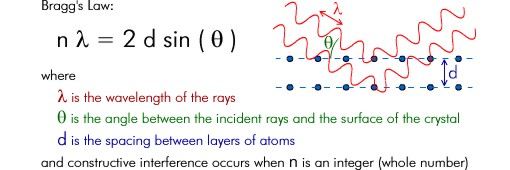Bragg's Law
Short Description of Topic
The Main Idea
Bragg's Law is a phenomenon in physics that relates the angles for coherent & incoherent scattering of crystal lattices, the wavelength of the incident wave, and the distance that the wave travels; the distance traveled by the wave depends on the separation of the layers and the angle at which the X-ray entered the material. This diffraction occurs when radiation, with wavelength comparable to atomic spacings, is scattered in a specular fashion by the atoms of a crystalline system, and undergoes constructive interference. The waves must interfere constructively in order for Bragg's Law to be valid. Also, the wave which reflected from the surface needs to have traveled a whole number of wavelengths while inside the material.
The path difference between two waves undergoing interference is given by 2dsinθ, where θ is the scattering angle. Bragg's Law ultimately describes the largest angle θ such that constructive interference is at its strongest.
A Mathematical Model
 n is an integer describing the order of the reflection.
n is an integer describing the order of the reflection.
Examples
Be sure to show all steps in your solution and include diagrams whenever possible
Simple
Middling
Difficult
Connectedness
- How is this topic connected to something that you are interested in?
- How is it connected to your major?
- Is there an interesting industrial application?
History
Put this idea in historical context. Give the reader the Who, What, When, Where, and Why.
See also
Are there related topics or categories in this wiki resource for the curious reader to explore? How does this topic fit into that context?
Further reading
Books, Articles or other print media on this topic
External links
References
http://www-outreach.phy.cam.ac.uk/camphy/xraydiffraction/xraydiffraction7_1.htm